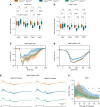SARM1 loss protects retinal ganglion cells in a mouse model of autosomal dominant optic atrophy
- PMID: 40344041
- PMCID: PMC12165793
- DOI: 10.1172/JCI191315
SARM1 loss protects retinal ganglion cells in a mouse model of autosomal dominant optic atrophy
Abstract
Autosomal dominant optic atrophy (ADOA), the most prevalent hereditary optic neuropathy, leads to retinal ganglion cell (RGC) degeneration and vision loss. ADOA is primarily caused by mutations in the optic atrophy type 1 (OPA1) gene, which encodes a conserved GTPase important for mitochondrial inner membrane dynamics. To date, the disease mechanism remains unclear, and no therapies are available. We generated a mouse model carrying the pathogenic Opa1R290Q/+ allele that recapitulated key features of human ADOA, including mitochondrial defects, age-related RGC loss, optic nerve degeneration, and reduced RGC functions. We identified sterile alpha and TIR motif containing 1 (SARM1), a neurodegeneration switch, as a key driver of RGC degeneration in these mice. Sarm1 KO nearly completely suppressed all the degeneration phenotypes without reversing mitochondrial fragmentation. Additionally, we show that a portion of SARM1 localized within the mitochondrial intermembrane space. These findings indicated that SARM1 was activated downstream of mitochondrial dysfunction in ADOA, highlighting it as a promising therapeutic target.
Keywords: Cell biology; Mitochondria; Neurodegeneration; Neuroscience; Therapeutics.
Conflict of interest statement
Figures







References
MeSH terms
Substances
Grants and funding
LinkOut - more resources
Full Text Sources
Research Materials

